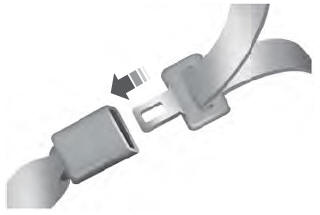Lincoln Aviator: All-Wheel Drive / Driving on Snow and Ice
WARNING: If you are driving in slippery conditions that require tire chains or cables, then it is critical that you drive cautiously. Keep speeds down, allow for longer stopping distances and avoid aggressive steering to reduce the chances of a loss of vehicle control which can lead to serious injury or death. If the rear end of your vehicle slides while cornering, steer in the direction of the slide until you regain control of your vehicle.
Note: Excessive tire slippage can cause driveline damage.
AWD vehicles have advantages over 2WD vehicles in snow and ice but can skid like any other vehicle.
Should you start to slide while driving on snowy or icy roads, turn the steering wheel in the direction of the slide until you regain control.
Avoid sudden applications of power and quick changes of direction on snow and ice. Apply the accelerator slowly and steadily when starting from a full stop.
Avoid sudden braking as well. Although an AWD vehicle could accelerate better than a two-wheel drive vehicle in snow and ice, it will not stop any faster, because as in other vehicles, braking occurs at all four wheels. Do not become overconfident as to road conditions.
Make sure you allow sufficient distance between you and other vehicles for stopping. Drive slower than usual and consider using one of the lower gears. In emergency stopping situations, apply the brake steadily. Since your vehicle is equipped with a four wheel (ABS), do not “pump” the brakes.
 Driving in Special Conditions With All-Wheel Drive (AWD)
Driving in Special Conditions With All-Wheel Drive (AWD)
Note: Use of the AWD system in slippery,
deep snow and sand drive modes on dry
surfaces could produce some vibration and
driveline bind up and, or excessive tire wear,
as the intent of these drive modes are for
slippery and loose surfaces...
 Maintenance and Modifications
Maintenance and Modifications
The suspension and steering systems on
your vehicle have been designed and tested
to provide predictable performance whether
loaded or empty and durable load carrying
capability...
Other information:
Lincoln Aviator 2020-2025 Service Manual: Removal and Installation - Front Door Glass Top Run
Removal NOTE: LH (left-hand) side shown, RH (right-hand) side similar. NOTE: Removal steps in this procedure may contain installation details. Remove the front door window glass. Refer to: Front Door Window Glass (501-11 Glass, Frames and Mechanisms, Removal and Installation)...
Lincoln Aviator 2020-2025 Service Manual: Diagnosis and Testing - Leakage Inspection
Leak Check Test With the vehicle in NEUTRAL, position it on a hoist. REFER to: Preliminary Inspection (307-01A Automatic Transmission - 10-Speed Automatic Transmission – 10R60, Diagnosis and Testing). Inspect the gasket and sealing areas for evidence of leakage...
Categories
- Manuals Home
- Lincoln Aviator Owners Manual
- Lincoln Aviator Service Manual
- Anti-Theft Alarm
- Remove and Reinstall the Battery
- Keyless Entry
- New on site
- Most important about car
Fastening the Seatbelts
The front outboard and rear safety restraints in the vehicle are combination lap and shoulder belts.
Insert the belt tongue into the proper buckle (the buckle closest to the direction the tongue is coming from) until you hear a snap and feel it latch. Make sure that you securely fasten the tongue in the buckle.
